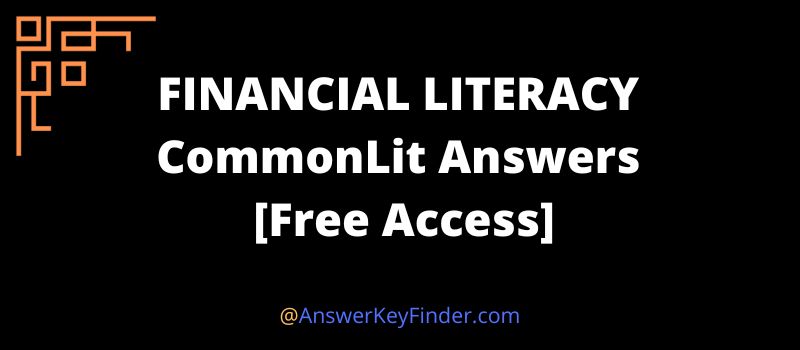In this session, we will be revealing FINANCIAL LITERACY CommonLit answers which are absolutely FREE to view.
Before publishing, every answer for the FINANCIAL LITERACY CommonLit informational text undergoes a thorough review to ensure its accuracy & reliability. If you find them helpful, please don’t hesitate to share.
FINANCIAL LITERACY CommonLit Answers – FREE Access
Find the answer key for the topic “FINANCIAL LITERACY” below:
Note: Be prepared to share your original ideas in a class discussion.

Discussion Questions & Answers
Following are our answers based on the questions provided:
Q.1. What experiences do you have with the different options available for spending and saving money discussed in the text? How do you think you will manage money in the future?
Ans: I am familiar with all of the various spending and saving strategies that are presented in the text since I have personal experience with them. My day-to-day payments and other essential expenditures are paid for using a checking account, which I maintain for that purpose. I put any money that I won’t be using in the near future into a savings account that I have. In addition to that, I have used loans to pay for things like tuition and auto expenses. I had also made use of credit cards, which meant that I had a monthly balance that needed to be paid off. In the future, I intend to continue making use of my checking and savings accounts, and I will only turn to credit cards in cases where none of my other payment options are viable. I intend to continue putting as much money as I can away in savings each month, and I won’t apply for a loan unless it’s really necessary.
Q.2. In the context of the text, does money buy happiness? How does saving money versus spending money lead to different types of happiness? What are the benefits and disadvantages of both?
Ans: According to the information provided by the text, happiness can be purchased with money, but only to a certain extent. Having a financial buffer can provide mental relief, and saving money is a sort of security that can help you achieve that. On the other hand, spending money may be a source of excitement and pleasure, particularly when it is spent on activities or on things that get us closer to achieving our objectives. The benefits of spending money include having new experiences, getting closer to our goals, and being able to enjoy life, whereas the benefits of saving money include having security, stability, and the capacity to make long-term investments. One of the drawbacks of saving money is that it prevents you from indulging in activities that provide instant gratification. On the other hand, one of the drawbacks of spending money is that it puts you at risk of incurring debt and prevents you from having sufficient funds to accomplish your long-term objectives.
Q.3. In the context of the text, what is the goal of education? In what ways do you think “financial literacy” is a form of education? Should financial literacy be a class in school? What would be a good method for teaching financial literacy?
Ans: The goal of education is to help people understand how to manage their money. I think that financial literacy should be taught in schools because it can help students be able to manage their money now and in the future. A good method for teaching financial literacy is to assign projects that get students interested in learning about finance.
Guiding Questions & Answers
Following are our answers based on the questions provided:
Q.1. PART A: Which of the following identifies the central idea of the text?
Ans: Financial choices can be confusing, but knowledge can help a person make good decisions.
Q.2. PART B: Which detail from the text best supports the answer to Part A?
Ans: ” Financial systems are extremely complicated, which unfortunately means there are too many people who do not understand how to use their money in the best ways.” (Paragraph 1)
Q.3. PART A: Which sentence best describes one aspect of the relationship between banks and their clients?
Ans: Banks can use clients’ money for loans and clients can make money on interest.
Q.4. PART B: Which quote from the text best supports the answer to Part A?
Ans: ” Banks like to give out loans because when someone borrows money, they have to pay that money back along with interest on the money” (Paragraph 7)
Q.5. What is the effect of the author proposing a “thought experiment” at the beginning of the text?
Ans: It was used to help the reader better understand money and how to spend money.
You can find answer keys for other grades here:
=> CommonLit All Grade Answers
Note: In case, you have anything to share related to this topic let us know through the comment box below.
Conclusion
In CommonLit, “FINANCIAL LITERACY” is one of the students’ favorite informational texts authored by Jessica McBirney for grade 7 students.
In this informative text, Jessica McBirney delves into the multitude of choices individuals can make regarding their finances, providing detailed insights and engaging analysis.
Hope you got the FINANCIAL LITERACY CommonLit Answers Key for free as promised. Share with your batchmates if you find this helpful.
Hi, I’m Annie Smith, and I’ve been a teacher for over 5 years and have taught students at all levels. I love to help students get ahead of their exams and provide helpful guides on various topics.
